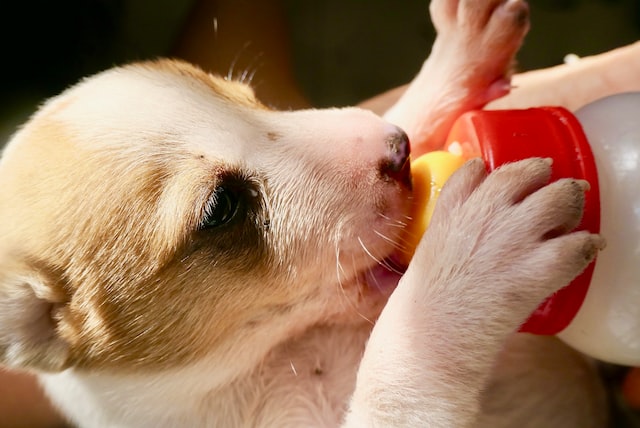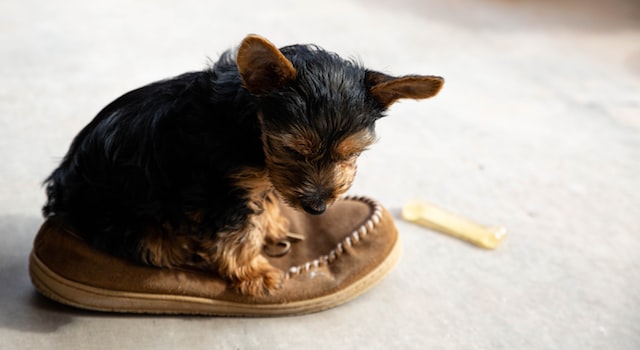
Determining the adult size of a puppy can be tricky, as there are many factors that can influence a dog's growth and development. While it's not possible to predict exactly how big a puppy will get, understanding the various factors that can affect a puppy's size can help you get a rough idea of what to expect.
In this blog post, we'll discuss some of the most important factors that influence a puppy's adult size and provide examples of small and large dog breeds and their typical weight ranges, as well as their expected weight at 6-8 weeks of age.
Table of Contents
Using Genetics to Determine a Puppy’s Adult Size

One of the most significant factors that determine a puppy's adult size is genetics. The size of a puppy's parents, grandparents, and other relatives can give you a good indication of what to expect. For example, if both parents of a puppy are small breeds, the puppy is more likely to be small as well. On the other hand, if one or both parents are large breeds, the puppy is more likely to be larger.
Examples of small dog breeds and their weight range:
- Chihuahua: Adult weight 3 - 6 pounds, 6-8 weeks old: around 1-2 pounds
- Pomeranian: Adult weight 3 - 7 pounds, 6-8 weeks old: around 1-2 pounds
- Yorkshire Terrier: Adult weight 4 - 7 pounds, 6-8 weeks old: around 1-2 pounds
- Shih Tzu: Adult weight 9 - 16 pounds, 6-8 weeks old: around 2-3 pounds
Examples of large dog breeds and their weight range:
- Great Dane: Adult weight 110 - 190 pounds, 6-8 weeks old: around 8-15 pounds
- Saint Bernard: Adult weight 140 - 260 pounds, 6-8 weeks old: around 8-15 pounds
- English Mastiff: Adult weight 120 - 230 pounds, 6-8 weeks old: around 8-15 pounds
- Leonberger: Adult weight 90 - 170 pounds, 6-8 weeks old: around 8-15 pounds
RELATED: How Big Do Mini Bernedoodles Get?
Nutrition Plays a Big Role in Determining How Big a Puppy Will Get

Another important factor that can influence a puppy's adult size is nutrition. A puppy that is fed a high-quality diet, with the right balance of protein, carbohydrates, and fat, is more likely to reach its full potential size than a puppy that is underfed or overfed. Additionally, providing a puppy with a diet that is specially formulated for large breeds can help promote healthy growth and development.
RELATED: 11 Human Foods You Can Feed Your Dog
Hormonal Imbalances Can Alter a Puppy’s Expected Adult Size

Hormonal imbalances in a puppy can also impact growth. Some conditions such as hypoglycemia, hypothyroidism, and growth hormone deficiencies can cause a puppy to be smaller than expected. Therefore, it’s always recommended to find a reputable dog breeder when deciding to get a new puppy. A reputable breeder tests the puppies and their parents for any genetic defects and ensures that each puppy is healthy before reservation.
RELATED: 7 Ways to Identify a Responsible Breeder
Female Vs Male Sizes

The sex of a puppy can also influence its adult size. Male puppies are generally larger and heavier than female puppies of the same breed and age. Although the difference is not as significant in some smaller breeds, it may be a bit more obvious in larger breeds. Large breeds can have a difference of up to 30 pounds between males and females of the same breed and age, while small breeds can either weigh the same or have very little difference when it comes to weight.
RELATED: Cavapoo Size Guide: How Big Do Cavapoos Get?
Exercise

Exercise is also an important factor in determining a puppy's adult size. Puppies that are allowed to run and play freely, and that get regular exercise, are more likely to reach their full potential size than puppies that are confined and not allowed to move around.
RELATED: Week One with A New Puppy: See What to Expect
Spraying or Neutering a Puppy Can Alter Their Expected Size

Spay or Neuter: spaying or neutering a puppy can also impact its adult size. A dog that has been spayed or neutered is less likely to reach its full potential size than a dog that has not been surgically altered. This is because the removal of the ovaries or testicles affects the production of hormones, which can inhibit growth.
RELATED: Meet the Incredibly Cute Teacup Pomeranian
Conclusion
While it is difficult to give a precise answer to how big a puppy will get without a thorough examination of the parents and all the influencing factors mentioned, using the average weight ranges for each breed, as well as their expected weight at 6-8 weeks of age can give you a rough idea of what to expect. It's important to remember that these are just estimates and that a puppy's size could vary depending on various factors. Additionally, it's important to note that 6-8 weeks old is a delicate stage of a puppy's life, and it should not be taken out of its mother and littermates before 8 weeks old at least. Feeding should also be based on the current weight of the puppy, not on its expected adult weight, and your vet should be consulted for a proper feeding plan.
It's important to provide your puppy with proper care and nutrition to ensure that it reaches its full size and becomes a happy, healthy adult dog. Regular veterinary check-ups are also important, as they can detect any potential health issues that may affect growth and development. With the right care and attention, your puppy has the potential to grow into a well-adjusted and loving companion.
When choosing a puppy, it's important to consider your lifestyle and living situation, as well as your expectations for the dog's size. Larger breeds may not be suitable for apartment living, while smaller breeds may not be suitable for families with young children. By understanding the various factors that can affect a puppy's adult size, you can make a more informed decision when choosing the right puppy for you and your family.
Scroll down to see FAQs about puppy growth!
What To Read Next
Learn How To Gift A Christmas Puppy The Right Way
10 Reasons Why Dogs Lose Interest in Training & How to Fix it
Frequently Asked Questions
Can puppy be bigger than parents? Yes, puppies can be bigger than their parents. This can happen due to a variety of factors such as genetics, diet, and environment. Some breeds of dogs have a wide range of size variations within the breed, and puppies from the same litter can have different growth patterns. Additionally, certain genetic mutations can lead to larger size in puppies. However, proper nutrition and healthcare play an important role in a puppy's growth and development, so puppies that are well-cared for are more likely to reach their full potential size.
Can you predict a dog's size? It is possible to predict a dog's size to some degree, but it is not an exact science. The size of a dog can be determined by its breed, genetics, and nutrition. However, there can be variations within a breed and individual puppies may not conform to the breed standard. A dog's size at maturity can also be affected by factors such as diet and exercise. It's usually possible to have an estimate of the size of a dog when fully grown by looking at its parents size, breed standard and measuring its growth rate at different stages of its development.
What determines puppy size? Puppy size is mainly determined by genetics, breed and nutrition. Environmental factors can also play a role in a puppy's growth and development.
How to tell puppy size by paws? It is not entirely accurate to predict a puppy's adult size based on its paw size alone. However, as a general rule, a bigger paw size can indicate that a puppy will be a larger adult dog. However, it's important to consider other factors such as breed and genetics when trying to predict a puppy's adult size. Additionally, a puppy's paws may not be fully developed until it reaches maturity, so it's best to wait until the puppy is fully grown before trying to predict its adult size.
How to chart puppy size? One way to chart a puppy's size is to regularly measure its weight and length and keep a record of the measurements. You can also track the puppy's girth (circumference of the widest part of the chest) and height (measured from the ground to the top of the shoulders) . This information can be used to create a growth chart, which can help you track the puppy's progress and ensure that it is growing at a healthy rate. It can also help to detect any potential growth issues early on. Additionally, you can compare your puppy's measurements to breed standards or growth charts for the specific breed to get an idea of how your puppy is growing in relation to other dogs of the same breed.
How to predict puppy size based on parents? One way to predict a puppy's size based on its parents is to look at the breed standard for the puppy's specific breed. Many breeds have a range of sizes that they can reach as an adult, and looking at the breed standard can give an idea of the typical size range for that breed. Additionally, you can look at the size of the puppy's parents, as it's likely that the puppy will be similar in size to its parents. You can also compare your puppy's measurements to breed standards or growth charts for the specific breed to get an idea of how your puppy is growing in relation to other dogs of the same breed. However, it's important to keep in mind that genetics can be unpredictable, and there may be variations in size within a litter, so these predictions may not be exact.
When do medium-sized puppies stop growing? Medium-sized puppies typically stop growing between 12 to 18 months of age, but it can vary depending on the breed. Some breeds may take up to 24 months to reach full maturity and stop growing.
How long does a take for a puppy to reach full size? The time it takes for a puppy to reach full size varies depending on the breed. Small breeds typically reach full size at around 9 to 12 months of age, medium-sized breeds at 12 to 18 months, and large breeds can take up to 24 months to reach full size. However, some breeds may continue to fill out in terms of muscle and bone density even after they've reached their full height and weight.
Does puppy size indicate dog size? Puppy size can indicate adult dog size to some extent, but it is not a definitive indicator. The size of a puppy can be influenced by various factors such as genetics, breed, nutrition and environment. Puppies from the same litter may have different growth patterns and some breeds have a wide range of size variations. However, a puppy's size at birth and its rate of growth during the first few months can provide some indication of its potential adult size, but it's important to keep in mind that it's not a definite indicator and other factors such as genetics and nutrition can play a role in a puppy's adult size.




